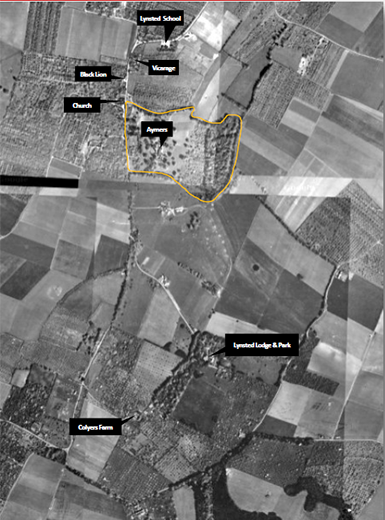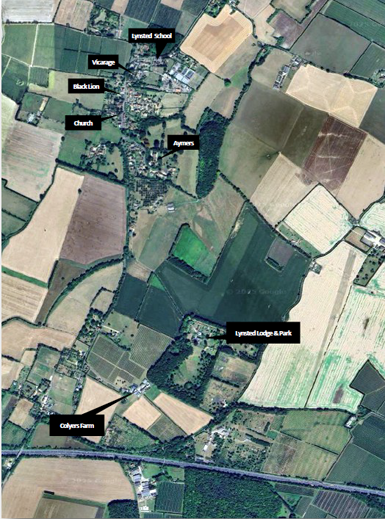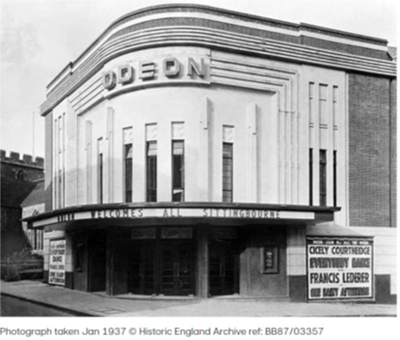The "Aymers Cup" and a mystery solved
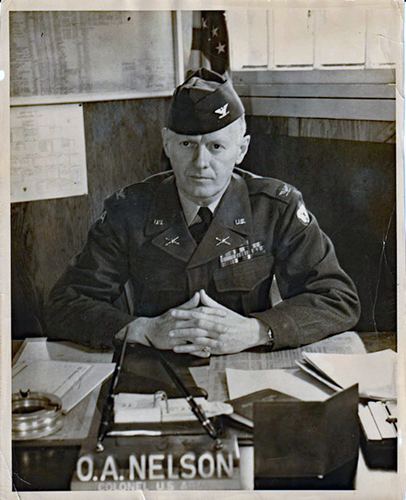
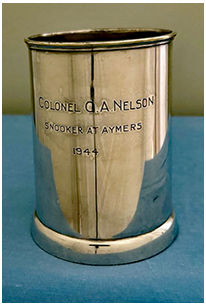 There has long been mention that US troops were stationed in Lynsted in WW2. However, it has never been clear who, when and where. So it was with much excitement that, via the Lynsted with Kingsdown Society website, we received a request for information from Paul Nelson of Johns Island, South Carolina, USA. Grandson of Colonel Ola A Nelson, commander of the US Army's 24th Anti-Aircraft Artillery Group, Paul shared a photograph of a silver cup engraved "Colonel O A Nelson, Snooker at Aymers, 1944". This gave us a time, a place and US Army unit which has allowed us to find out so much more for both Paul and for the history of Lynsted.
There has long been mention that US troops were stationed in Lynsted in WW2. However, it has never been clear who, when and where. So it was with much excitement that, via the Lynsted with Kingsdown Society website, we received a request for information from Paul Nelson of Johns Island, South Carolina, USA. Grandson of Colonel Ola A Nelson, commander of the US Army's 24th Anti-Aircraft Artillery Group, Paul shared a photograph of a silver cup engraved "Colonel O A Nelson, Snooker at Aymers, 1944". This gave us a time, a place and US Army unit which has allowed us to find out so much more for both Paul and for the history of Lynsted.
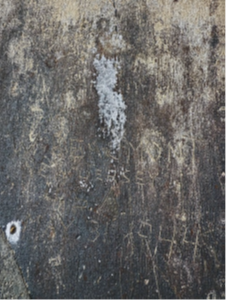 Thanks to the current owners of Aymers, Mrs & Mrs Sherwin, we were able to confirm that the senior staff of the US 24th Anti-Aircraft Artillery Group (24th AAA) were stationed in Aymers. In particular we are very grateful to Mrs Sherwin who ventured up on the roof of Aymers to capture evidence of the presence of the US troops. On a lead panel on the roof there is an inscription that reads "W Beaumont, New Jersey, USA, May 31, 1944".
Thanks to the current owners of Aymers, Mrs & Mrs Sherwin, we were able to confirm that the senior staff of the US 24th Anti-Aircraft Artillery Group (24th AAA) were stationed in Aymers. In particular we are very grateful to Mrs Sherwin who ventured up on the roof of Aymers to capture evidence of the presence of the US troops. On a lead panel on the roof there is an inscription that reads "W Beaumont, New Jersey, USA, May 31, 1944".
At the time of the visit of the 24th AAA, Aymers was in the ownership of Lewis Reginald Comyn Ching. A veteran of the First World War, he took charge of the Home Guard, 9th Kent (Faversham) Battalion during WW2.
It came as no surprise that Captain Ching would organise a snooker competition. He was a very keen sportsman and in his younger days had played football, tennis and cricket. He opened up Aymers for the annual village fete, VE day celebrations and the coronation of Queen Elizabeth II. He would take charge of sport competitions.
Arrival of the US Army 24th Anti-Aircraft Artillery Group - 1944
In 1944, the men of the 24th AAA sailed in to Glasgow, Scotland. They moved on to Pontypridd then, around May/June the men arrived in Lynsted.
At that time the country was witnessing extensive movement of troops and equipment, especially in the south of England. This hinted that the long-awaited D-Day was coming. Where and when was obviously secret. It is true to say that the country was a little jaded after five years of war, rationing, evacuations, the constant threat of bombing and the fear for the lives of the own men and women serving their country. D-Day could not come soon enough. Hopefully the people of Lynsted welcomed the men of the 24th AAA and they were made to feel welcome.
We have heard reports from villagers, who were children at the time of the war, of how exciting it was for them. One of our farmers has told of his Uncle, who was very young at the time of WW2, and who was hit by a US Army lorry in our neighbouring village of Doddington. Luckily, he was just shaken-up but spoke of the kindness of the US soldiers who came to his aid.
However, for all its bucolic feel, this area was not as tranquil as it could have been. This was hinted at in the illustrated diary produced by a member of the 24th AAA who chronicled their journey from arrival at Glasgow to the long fight through Europe. This shows a doodlebug flying over the Black Lion Public House in Lynsted village. Just two days after the men left for Southampton, the Black Lion Pub was badly damaged when a doodlebug fell in the orchard behind it.
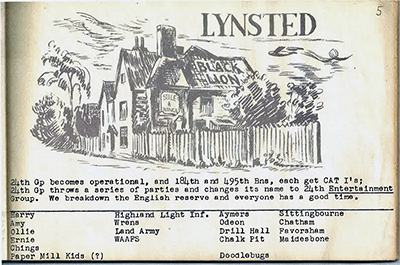 |
Extract from the "Travels of the 24th AAA Group" showing a Doodlebug over Lynsted. Enlarge image. More on this fascination diary below |
Where Troops were Billeted
Operation Fortitude - South
As D-Day approached, troops and military hardware from the UK, US and Canada were moved to Kent as part of "Operation Fortitude - South", one of WW2’s greatest deception plans. The goal was to convince the Germans that the main Allied invasion would occur in the short hop to Pas-de-Calais area of France rather than in Normandy.
The following is from the transcript of the Imperial War Museum’s short video (available to view via https://www.iwm.org.uk/history/the-lies-and-deceptions-that-made-D-day-possible).
A transcript of the video is also available at Annex 2:
"In January of 1944, the Allies formed the First United States Army Group. Based in South-East England, it was placed under the command of General George S. Patton, one of the most well-known American generals of the war.
German reconnaissance aircraft soon began reporting on a build-up of forces in the area, noting large convoys of tanks, and a number of landing craft gathered in harbours and estuaries all over southeast England. They also picked up Allied radio transmissions relating the Army’s movements. It could mean only one thing. The build-up of forces, and particularly General Patton’s presence in the area, meant the Allies were preparing to land in the Pas de Calais. But this was all part of the plan. In fact, the FUSAG didn’t exist at all, it was an entirely fictional army created for the sole purpose of deceiving German intelligence. The armoured convoys were made up of inflatable, dummy tanks and deliberately placed within sight of German reconnaissance aircraft. While the landing craft were actually made out of wood, canvas and empty barrels.
Every effort was made to make the Army seem as real as possible - going so far as to create physical insignia and uniforms. This ruse was supported by the transmission of fake radio messages, and further solidified by false information fed to the Germans by a number of trusted double agents and spies."
Troops remained in Kent for a time after the 6 June landings as the deception continued. Even General Patten remained in England until 9 July. Hitler and his staff still believed there was to be an invasion in the Pas-de-Calais region.
Illustrated Diary of the Travels of the 24th AAA Group
The Society has been privileged to see a copy of the illustrated booklet that chronicles the 24th AAA journey from the US, through the UK and on to occupied Europe. Indeed, Col Nelson’s own personal copy.
We are happy to be able to identify some of the people and places that have been mentioned on the "Lynsted" page (below). (You can read the whole "Travels of the 24th AAA Group" booklet using this link to the PDF):
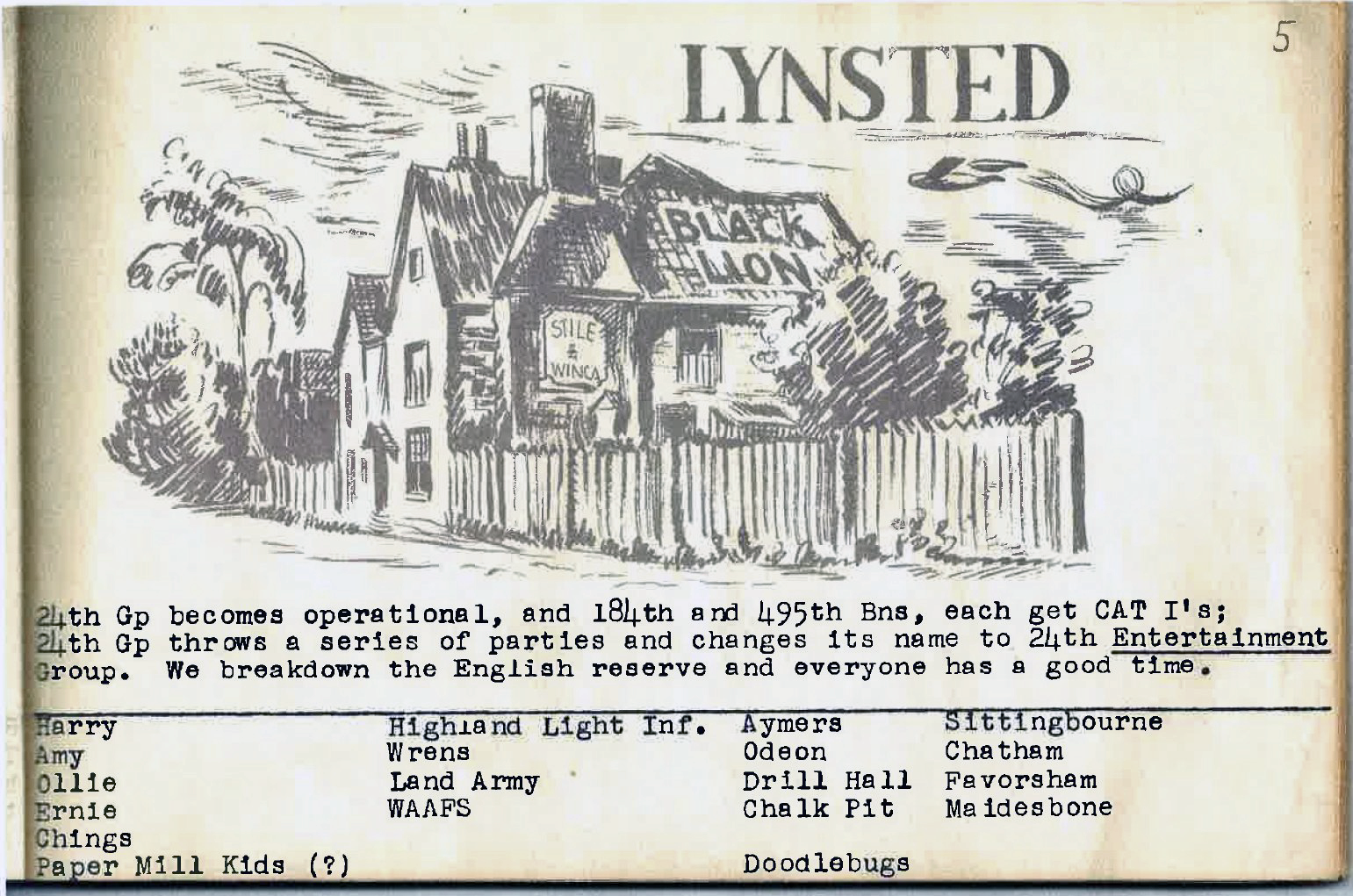
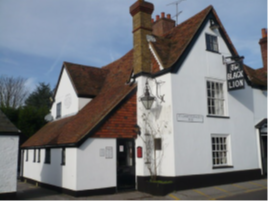 The Black Lion
The Black Lion
The Black Lion is still going strong.
The 184th and 495th AAA Battalions
We know that the 184th AAA Battalion was stationed at Northwick, Canvey Island, Essex. The 495th AAA Battalion was situated in Seaford on the south coast in Sussex.
Harry, Amy, Ollie and Ernie
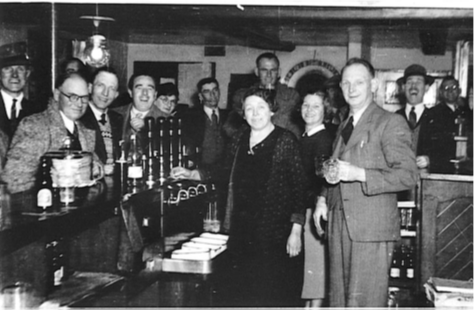 Ollie (Olive) and Ernie Branch were the licensees of the Black Lion Pub. Amy Sutton worked for them. “Harry” is probably Harry Day, a regular at the Black Lion.
Ollie (Olive) and Ernie Branch were the licensees of the Black Lion Pub. Amy Sutton worked for them. “Harry” is probably Harry Day, a regular at the Black Lion.
Sadly, Ernest lost his son (Olive’s Stepson) Harry in Belgium. He was ambushed and killed in hand-to-hand combat with a number of German soldiers while on a reconnaissance mission for the Royal Artillery on 6 September 1944.
Chings/Aymers
Captain and Mrs Ching were living at Aymers at this time.
Paper Mill Kids and Sittingbourne
Our nearest town of Sittingbourne, situated 2 miles to the west. There is a large paper mill there. “Paper Mill Kids” may refer to the children who were encouraged to collect paper to be re-pulped. During WWII, children were encouraged to collect materials like waste paper, scrap metal, and other recyclable item for the war effort. Rumour has it they could be “persuasive”!
Highland Light Infantry
Thanks to the correspondence from Paul Nelson, research has now shown that the 1st Battalion Highland Light Infantry was also billeted in Lynsted on the run up to D Day.
The 1st Battalion, Highland Light Infantry (City of Glasgow Regiment) formed part of the 53rd (Welsh) Division. The 1st Battalion landed in France in September 1939 as part of the 127th (Manchester) Brigade in the 42nd (East Lancashire) Division for service with the British Expeditionary Force and then took part in the Dunkirk evacuation in June 1940.
After D-Day they were involved in the Battle of the Bulge, the Battle of the Reichswald, and the advance into Germany.
On searching we found an extract of the 1st Battalion The Highland Light Infantry’s official War Diary for the period of the build up to their embarkation to Normandy. We have included the extract below as an illustration of the arrangements required:
WO171/1309 Battalion Diary: 1st – 30th June
Commanding Officer: Lieutenant-Colonel T Macleod
Location: Lynstead [sic]
VEHICLE MOVEMENTS1–6th June – Normal training went on with a considerable amount of sport and games. Weather extremely good sunny and [hot].
6th June – D Day for Operation ‘Overlord’. British, Canadian and American assault troops invaded Normandy. With effect from 0001 hours. Today all leave is stopped and the Battalion is at 6 hours notice to move to a Marshalling Area.
It is now apparent that 12th Corps of which this Battalion forms part is to be used in a ‘Build Up’ role.
15th June – The Advance Party comprising Captain FCS Lewin-Harris and 7 ORs with a 15cwt truck moved off to Brigade HQ at 2000 hours. They moved to the Marshalling Area as a Brigade Advance Party at 0400 hours 16th June.
16th June – Tracked vehicles left by rail for Marshalling Area at 2230 hours, commanded by Captain J [Liojour].
17th June – Vehicle party moved off to Marshalling Area at 0600 hours. The Commanding Officer and Adjutant accompanied the Vehicle Party (strength 285 all ranks). Marching Party moved to Marshalling area – entraining at Teynham 1400 hours, detraining Haywards Heath.
The 2I/C Major CA Harrey and the Intelligence Officer accompanied the Marching Party (remainder of Battalion). A residue of 13 ORs commanded by Servant Danger[field] was left at Sittingbourne to bring on the [illegible] vehicles i.e. surplus to higher s[illegible] (3 15cwts, 3 Loyd Carriers, 1 Jeep, 1 PV, 1 Trailer 15 cwt truck).
Vehicle party arrived T.3 Marshalling Area, Royal Albert Docks, London at 1200 hours. 18th June – The Marshalling Area – Only excitement was created by German ‘P’ Planes (Pilotless aircraft). 6 crashed near the Marshalling Area.
19th June – 0640 – Vehicles including tracked vehicles moved to [illegible] Area – West India Docks.
1400 – Commenced loading on to SS Samzona an American Liberty ship leased to Britain and sailing under the Red Ensign.
Total complement of military personnel, 57 Officers and 554 ORs with 153 vehicles. This was made of some 23 detachments from 8 Corps HQ, 43 Division, 53 Division and 59 Division. The 1 HLI is however the largest on board.
Captain of the Ship: Captain AN Anderson
Troops: Lieutenant-Colonel T Macleod
Ships Adjutant: Captain JS [Illegible]1100 – Embarked
Location: On board SS Samzona1400 – Sailed
1900 – Anchored in the estuary off South end in company with many other vessels of a similar type (MT Ships) and several LST.
It is understood that the convoy has been held up here for several days owing to high winds on the Normandy beaches making unloading impossible.
21st/23rd June - We remained at anchor off Southend the weather was dry and warm in the bright sunshine on 21st and 23rd. Severe overcrowding on the [illegible] troop decks and few facilities for cooking. All ranks remained cheerful and morale was extremely high. The morning was clustered to Officer Commanding inspection of the ship and physical training in the afternoon. Deck Horse Racing was organised and created a lot of excitement. On the 23rd two signals were sent ashore, the first for extra rations, 1 ½ cwt of soap for washing clothes and 15,000 cigarettes. The seconds for [illegible] vegetables and fruit on the advice of the Doctor.
24th June – PT this morning as usual.
1330 – Officer Commanding Troops and the Ship – Captain taken off to a convoy briefing conference. The morning additional ration was delivered. In the afternoon a launch came along side and bought a Field Cashier who had a payment of 5/- to everyman who wanted it. In addition, it delivered 15,000 cigarettes, 300 newspapers (free issue) and 1½ cwt of soap.
On the CO’s return from the briefing conference, he bought a package from the Medical Orderly containing a box of laxatives. The message enclosed in the packet is the answer to our request for vegetables is attached to the diary.1945 – The convoy sailed (approx 18 ships)
25th June – 0055 – We entered the Shelling area in the Straights of Dover. Military fire parties stood to until danger area was passed at approx 0300 hours. An oil tanker was seen blazing on the beach off Dover as a result of earlier German shelling, but our convoy was not attacked.
0800 – Off Beachy head, a briskly sunny morning.
2220 – Anchored off Courseuilles-sur-Mer, Normandy the Bay presents an astounding picture. A mass of ships of all types from coasters and small landing craft to large frigates and passenger boats. There are also several cruisers and a Capital Ship either the Nelson or Rodney. One cruiser and the Battleship went into action in support of the land forces. 2300 – All ships in the Bay area [send] smoke a AA protection.
26th June - 1400 – Commanding Officer
Adjutant, and Lieutenant EH Al[illegible]disembarked with 4 vehicles.
Moved to Assembly area at Colombia-sur-Mer and then to 71 Infantry Brigade Concentration area at Beny-sur-Mer. The Marching Party under the command of Major CA Harrey arrived at Beny on the previous evening.
TROOP MOVEMENTS
LYNSTEAD [sic]17th June – 1400 – The marching party, 23 officers and 504 ORs strong entrained at Teynham near Sittingbourne.
1630 – Detrained at Haywards Heath and marched to Marshalling Area Camp J.9.
18th/23rd June – Remained in Marshalling Area as disembarkation on Normandy beaches was postponed due to strong North-East gale. The stay of the party in the Marshalling Area was very pleasant, the ‘Hotel Service’ by the 61st Division was excellent. Four reinforcements joined the marching party.
24th June – Sailed from Newhaven in three ships. Two parties in LCI and one in an LSI.
It appears that, even though the Highland Light Infantry had obviously a lot on their minds, they still made time for their troops and pipe band to give a display in fund raising for the “Savings Week”. In WW2, National Savings Weeks was a campaign set up by the War Office to support the war effort.
The following extract from the Faversham News and East Kent Journal on Friday 16th June 1944 explains:
Teynham and Lynsted Once again Teynham and Lynsted have carried through their part in a special Savings Week with great success. In previous weeks there have usually been two or three investments of over £l,000 but this time it was essentially the enthusiasm and cooperation of the "small" investors which produced the splendid total of approximately £8,000* through the two Post Offices and the Savings Shop, for in that total there was only one amount of over £500 and it was less than £1,000. The Week started with a parade in Station Road of the Pipe Band and a detachment from a Battalion of The Highland Light Infantry before a large crowd. After the march the Band beat Retreat, a stirring performance which was greatly appreciated. Assembling then in the "Dover Castle" Car Park, Mr. L. Bull briefly called upon the inhabitants to save during the Week until it hurt (!) so as to make the Salute to our magnificent soldiers a very real salute. He afterwards led the crowd in giving thanks to the Band and the Troops for their fine display. The soldiers were subsequently entertained in the Y.M.C.A. canteen to tea, prepared and served by Mrs. Bull, Mrs. Moss and Miss Eileen Baker. In the evening of Saturday (the 3rd) a most successful and enjoyable whist drive took 'place. This was organised by ladies of the Lynsted and Teynham Women's Institute and produced the grand sum of £l4/5/10. On the following Tuesday evening a dance was held in the Y.M.C.A. Canteen. The hut was packed and a great time was had. At 9 p.m. all listened to the speech of His Majesty the King, and at the end of the dance, after the National Anthem. three verses of "O God our help in ages past" were sung. This dance produced a total of £29/19/6. |
WRENS, WAAFs and Land Army
Women from the forces would have been a common sight. With Kent being the “first line of defence”, and our proximity to the Royal Naval Base at Chatham, our long coastline and several RAF airfields, women in the forces took up many roles. There were several listening posts and anti-aircraft gun emplacements around the area, many of which were manned by women. With many of the men away at war, the girls of the Land Army would have been essential to keep food production going.
Odeon/Sittingbourne Sittingbourne is the closest town to Lynsted, situated about 2 miles to the west. This would have been in easy reach for trips to the Odeon. |
|
Drill Hall/Faversham
In the 1830s the “Faversham Assembly Rooms” were built. Sadly, in 1848 they burned down. In 1849 the newly rebuilt hall was reopened. In 1869 the Military took on the building and were then used for military purposes. The building was taken out of military control in 2011. The Drill Hall is still in existence and is a Grade II listed building. |
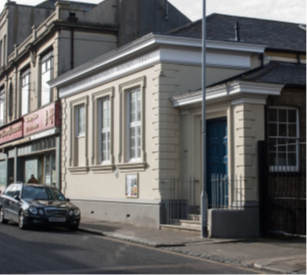 |
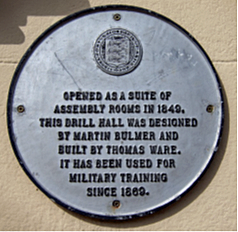 |
Chalk Pit
This may refer to the chalk quarries in nearby Sittingbourne. These were dug around 1870. Once excavated the chalk went through a wash mill driven by a stationary steam engine. Cast iron pipes then carried the washed chalk to Smeed Dean's cement works in nearby Murston.
Chatham and Maidstone
Chatham sits on the River Medway around 16 miles to the west of Lynsted. The Royal Navy Dockyard was based there (it closed in 1983 and now lives on as Chatham Historic Dockyard).
Maidstone is the County Town of Kent (approx. 15 miles from Lynsted) and had a large military presence. The home of Invicta Barracks (Invicta being the emblem of Kent). During WW2 it was the barracks and regimental depot and headquarters of the Queen's Own Royal West Kent Regiment and the regiment's Infantry Training Centre.
BACKGROUND NOTE
Operation Fortitude South: Transcript from Imperial War Museum short film “The Lies and Deceptions that made D-Day Possible”
Sources:-
How a fake Army fooled Hitler You Tube video
The Lies and Deceptions that made D-Day possible (IWM)
Voice over: "On Tuesday the 6th of June, 1944, nearly 160,000 allied soldiers landed along a 50-mile stretch of coast in Normandy, France. One of the most famous events of the Second World War; D-Day marked the beginning of the end for the Nazi Occupation of western Europe. But at the time, the German generals in charge of defending the beaches didn’t believe the full-scale Allied invasion of France had even begun. Thanks to a series of deception efforts undertaken by the Allies, the bulk of Germany’s defensive forces were 150 miles away when the Normandy landings were taking place."
Collection film footage: "The armies of the United Nations have made their first landings on the soil of Western Europe. Another of the great decisive battles of world history has been joined. This is D-Day."
Michelle Kirby: "I’m here at IWM London standing in the heart of the newly opened Spies, Lies and Deception exhibition. This part of the galleries explores how and why deception has been used in conflicts over the past century.
The D-Day deceptions were massively successful, and today they offer us a brilliant masterclass in military misdirection.
The aim of the D-Day deceptions was to keep German military leaders guessing about the place and time of the Allied invasion, so that the invading forces met as little opposition as possible. The hope was that this would give the Allies the maximum chance of success, saving lives in the process. Magruder’s Principle is the idea that it’s often much easier to deceive an enemy into hanging onto their pre-existing incorrect beliefs, than to trick them into changing those beliefs.
Voice over: "The D-Day deceptions would do exactly that. Although the Germans knew an invasion was coming, they did not know where and when it would take place. Hitler believed that the most likely target was the Pas de Calais - the shortest route across the English Channel - and it was this preconception that formed the bases for the deception plan.
Years of war had allowed for a variety of deception methods to gradually be refined and perfected by the Allies. This culminated in July 1943, when a top-secret group of military officers known as the London Controlling section began planning a huge deception operation. Codenamed ‘Operation Bodyguard’, it encompassed all aspects of deception relating to the Allied invasion of France. The initial plan outlined three key objectives: to make the Pas de Calais appear to be the main target, to mask the true date and time of the invasion, and to keep German forces in the Pas de Calais region, and elsewhere in Europe, for at least 14 days following the initial landings.
In January of 1944, the Allies formed the First United States Army Group. Based in South-East England, it was placed under the command of General George S. Patton, one of the most well-known American generals of the war.
German reconnaissance aircraft soon began reporting on a build-up of forces in the area, noting large convoys of tanks, and a number of landing craft gathered in harbours and estuaries all over southeast England. They also picked up Allied radio transmissions relating the Army’s movements. It could mean only one thing. The build-up of forces, and particularly General Patton’s presence in the area, meant the Allies were preparing to land in the Pas de Calais. But this was all part of the plan. In fact, the FUSAG didn’t exist at all, it was an entirely fictional army created for the sole purpose of deceiving German intelligence. The armoured convoys were made up of inflatable, dummy tanks and deliberately placed within sight of German reconnaissance aircraft. While the landing craft were actually made out of wood, canvas and empty barrels.
Every effort was made to make the Army seem as real as possible - going so far as to create physical insignia and uniforms. This ruse was supported by the transmission of fake radio messages, and further solidified by false information fed to the Germans by a number of trusted double agents and spies."
Michelle Kirby: "Juan Pujol Garcia was perhaps the most important double agent of the Second World War. Determined to spy for Britain, the Spaniard offered his services to German Intelligence in 1941, intending to become a double agent when he reached Britain, which eventually happened in April 1942. He was codenamed ‘Garbo’ by the British, after the famous actress Greta Garbo, as a nod to his own quite extraordinary ‘acting’ skills.
Double agents played a crucial role in the D-Day deceptions because they were by far the most effective way of misleading the German leaders. As preparations for D-Day progressed, it became the job of Agent Garbo and the other double agents to divert attention away from the impending Normandy landings.
To achieve this, Pujol created a fake network of 27 imaginary informants, which enabled him to send false information by radio to his Nazi handlers on all aspects of the Allied preparations. He even managed to convince them in the days immediately following D-Day, that the Normandy landings were just a ruse, intended to distract the Germans from the supposedly ‘real’ invasion target, the Pas de Calais.
This was so successful that, for weeks after D-Day, German leaders kept forces that could have reinforced Normandy, in the Pas de Calais area, waiting to repel a non-existent second invasion."
Voice over: "Alongside the deception efforts leading up to the invasion, were further operations during the landings themselves. These tactics aimed to keep the German defenders in the dark until the very last second, and make the invasion appear much larger and wider than it actually was."
Collection film footage: "Enemy radar installations were either destroyed, jammed or deceived by counterfeit presentations. The contrivance of radar signals misleading to the enemy involved at least one completely novel manoeuvre."
Michelle Kirby: "These strips of aluminium are known as Window. When dropped in large numbers from an aircraft, they reflect radar signals, producing a large blip on radar screens. In the early hours of D-Day, RAF aircrews dropped Window over the English Channel to trick the German radar operators into thinking that two large invasion fleets were heading at a speed of 8 knots towards the French coast, northeast of the Normandy beaches. They achieved this by flying repeatedly across the channel, each time dropping bundles of Window a little closer to the French coast. This required accurate navigation and precision flying that was so demanding that each aircraft had two pilots and two navigators on-board, working in shifts. The RAF’s elite Dambusters Squadron was tasked with one of these difficult operations.
The idea was to make the German defenders believe that Allied forces were about to land in Boulogne and Fécamp, while the real invasion fleet, hidden by radar jamming equipment, was in fact heading towards Normandy."
Voice over: "The real invasion force was further hidden through the use of smoke screens. Once laid down by ships or aircraft, they concealed the movement of Allied troops as they approached the Normandy coast, and reduced the risk of attack from German artillery and aircraft."
Michelle Kirby: "Dummy parachutists like this one were used to deceive the German defenders. Around 400 of these dummies, nicknamed Ruperts by the British, were dropped from aircraft, in key locations behind the German coastal defences in the early hours of D-Day.
They were typically made of hessian cloth, cord and brass eyelets, and tucked inside the pouch would be the parachute. And although they were smaller than life size, when viewed from the ground they were convincing enough. Some of the dummies were fitted with pyrotechnic devices that mimicked the sound of gunfire. It’s even been suggested that some were designed to explode on impact, to destroy the evidence. A few Special Forces men were dropped with the dummies to create more fake sights and sounds of battle.
The aim of the operation - to draw German troops away from the landing beaches - appears to have been successful, as the German army in Normandy sent a brigade of troops to look for the parachutists inland."
Voice over: "Despite the success of the deception operations, Allied forces still faced heavy resistance when they reached the shore. The Germans were still prepared for some kind of invasion, and they had fortified the Normandy coast with bunkers, artillery, and mines. The fighting on the first day of the landings was particularly fierce and the Allies made slow progress on some beaches. Casualties were high on both sides; however, the Allies were able to achieve their objective and establish a beachhead. D-Day was a major victory; it paved the way for the liberation of France and the eventual defeat of Nazi Germany."
Michelle Kirby: "Unsure of the time or place of the landings, the German forces were spread thinly across a wide stretch of coastline instead of being concentrated in Normandy to meet the invasion. When the Allies landed, they achieved precisely what they had been hoping for; the element of surprise. Some German Generals were slow to respond, refusing to believe that the main invasion had really begun.
There still remained a huge amount of fighting to be done following D-Day, and many challenges to be overcome before the Normandy campaign came to a close. Allied victory was by no means assured on D-Day, but it gave them the all-important first grip on the continent they needed, and the deception efforts played a crucial role in that.
If you want to learn more about the D-Day Deceptions, or see some of these objects for yourself – you can. Spies, Lies and Deception is IWM London’s brand-new exhibition exploring some of the most successful, surprising and shocking stories of espionage and deception from the past 100 years. From First World War dummy heads in the trenches, to Cold War spies, gadgets and more. This free exhibition is here until April 2024."

